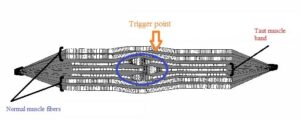Dry Needling
What is Dry Needling?
Dry needling (formally known as intramuscular therapy) is a technique utilizing small solid filiform needles that penetrate into the tissues. Dry needling targets muscular trigger points decreases muscle tone, decrease inflammation and normalize circulation to the affected area. Dry needling technique does not use medications.

Trigger points are small bands of muscle tissue that become unable to have normal function and can result in pain and normal function of the entire muscle. Trigger points can refer pain very far from the actual area where the trigger point is located. Therefore in some cases, some needling may be in a completely different part of the trunk or extremities.
If you are unsure if dry needling will benefit you, feel free to call our office or reach out on our contact page for more information.
Dry Needling is Not the Same as Acupuncture
This technique is NOT acupuncture. Though acupuncture needles are used in the dry needling technique, the technique is unlike acupuncture in that dry needling does not use acupuncture theory or meridians. In dry needling technique, the needles penetrate the affected muscles to break up trigger points in the muscle and soft tissues of the body.
There are several popular, well-established techniques of dry needling practice and they commonly involve the needling of myofascial trigger points using acupuncture needles to deactivate and help resolve trigger points. Our physical therapist will determine the best approach to use for your problem.
Dry needles are used to resolve soft tissue dysfunction, inflammation, contracture, tissue adhesion, microcirculatory dysfunction, and edema and balance the biomechanics of the musculoskeletal system.
Anyone Experiencing Pain Can Benefit From Dry Needling
Whether you are an athlete trying to return to your sport or someone who suffers from chronic muscle pain and tightness, dry needling may be the treatment you need to relieve your pain. Dry needling can be used to treat a wide variety of conditions including headaches, neck pain, shoulder impingement, tendinitis, back pain, carpal tunnel, tennis elbow, knee pain, arthritis, shin splints, and plantar fasciitis.
